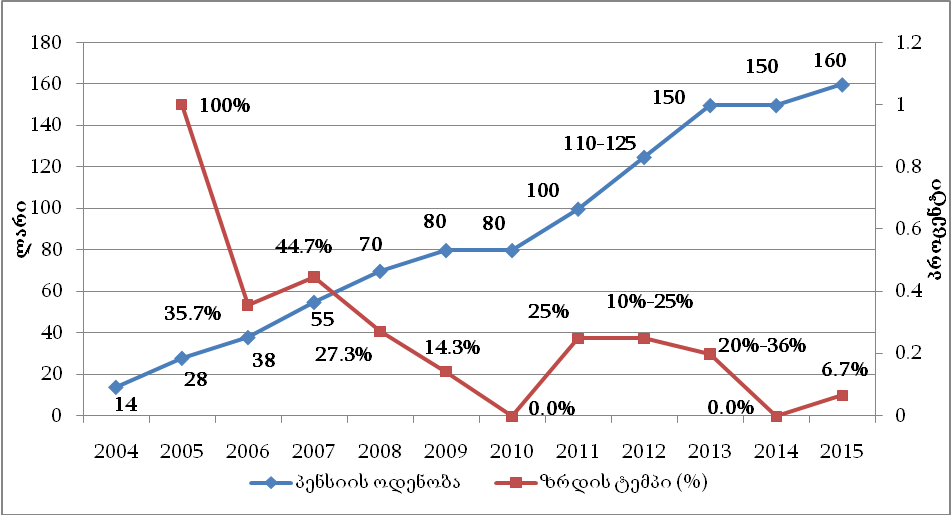On 4 March 2015, the Minister of Finance of Georgia, Nodar Khaduri, discussed the outcomes of the depreciation of GEL. Mr Khaduri stated: "Obviously, if debt is denominated is USD and recalculated in GEL, the volume of debt has increased."
FactCheck took interest in this topic and analysed the trends of national debt.
According to the information obtained from the Ministry of Finance, as of 28 February 2015, Georgia’s foreign debt equalled USD 4,072 million which is less than the number (USD 4,194 million) registered in February 2014. The decrease in the foreign debt was largely caused by the National Bank of Georgia’s foreign loan repayments. Last year, the National Bank repaid USD 75 million in debt to the International Monetary Fund. At the same time, if we calculate the state debt in GEL, we see that it has increased by GEL 1,480 million, from GEL 7,338 million to GEL 8,839 million, between February 2014 and February 2015.
Graph 1: Georgia’s National Foreign Debt (USD billion)
Part of Georgia’s foreign debt is denominated in USD and EUR which caused the aforementioned difference. According to the Statistics Bulletin of Georgia’s Foreign Debt, 48.5% of Georgia’s foreign debt was denominated in Special Drawing Rights (SDR) as of 30 June 2014. Additionally, 29.8% of Georgia’s foreign debt is denominated in USD and 17.9% is denominated in EUR. International organisations usually use the exchange rate of Special Drawing Rights which is a compound exchange rate of the four major world currencies (USD, EUR, JPY and GBP).
Graph 2: Structure of National Foreign Debt (%)
According to the National Bank of Georgia, the USD to GEL exchange rate was fixed at 1.75 and the EUR to GEL exchange rate was fixed at 2.39 at the end of February 2014. At the end of February 2015, the USD to GEL exchange rate soared to 2.17 whilst the EUR to GEL exchange rate rose to 2.43. It must be noted that when GEL is depreciated, the burden of foreign debt is increased because the state budget receives revenues in GEL whilst debts are denominated in foreign currency. Therefore, the state has to purchase foreign currency to pay its debts.
Normally, the state’s foreign debt burden is calculated by comparing the ratio of foreign debt to the country’s nominal Gross Domestic Product. According to the data published by the Ministry of Finance since 2003, Georgia’s debt to GDP ratio dropped significantly. Later, in the wake of the global financial crisis and the Russia-Georgia war, the ratio was increased in 2008-2010 but then continued to fall from 2011. Data for 2014 are not yet available although the forecast nominal GDP equalled GEL 29.3 billion according to the 2014 state budget. Georgia’s foreign debt was GEL 7.8 billion as of 31 December 2014. At the end of 2014, therefore, Georgia’s national foreign debt constituted 26.7% of the country’s GDP.
Graph 3: Total National and Foreign Debt Ratio to GDP
FactCheck has already published an article in regard to the impact of the GEL exchange rate upon the volume of Georgia’s foreign debt.
Conclusion
Of the total amount of Georgia’s national debt, 74% comprises foreign debt. Therefore, the depreciation of GEL has a significant impact upon the volume of debt. Georgia’s foreign debt equalled USD 4,072 million as of 28 February 2015 which is less than the number (USD 4,194 million) registered in February 2014. At the same time, if we recalculate the national debt in GEL, we see that Georgia’s foreign debt has increased by GEL 1,481 million (from GEL 7,338 million to GEL 8,839 million). Consequently, the burden of foreign debt has increased which should be reflected in the amended budget of 2015. As a result of the depreciation of GEL, the foreign debt service (principal plus interest rate repayment) will rise by GEL 140 million in 2015.
FactCheck concludes that Nodar Khaduri’s statement: "If debt is denominated is USD and recalculated in GEL, the volume of debt has increased," is TRUE.
Tags:











